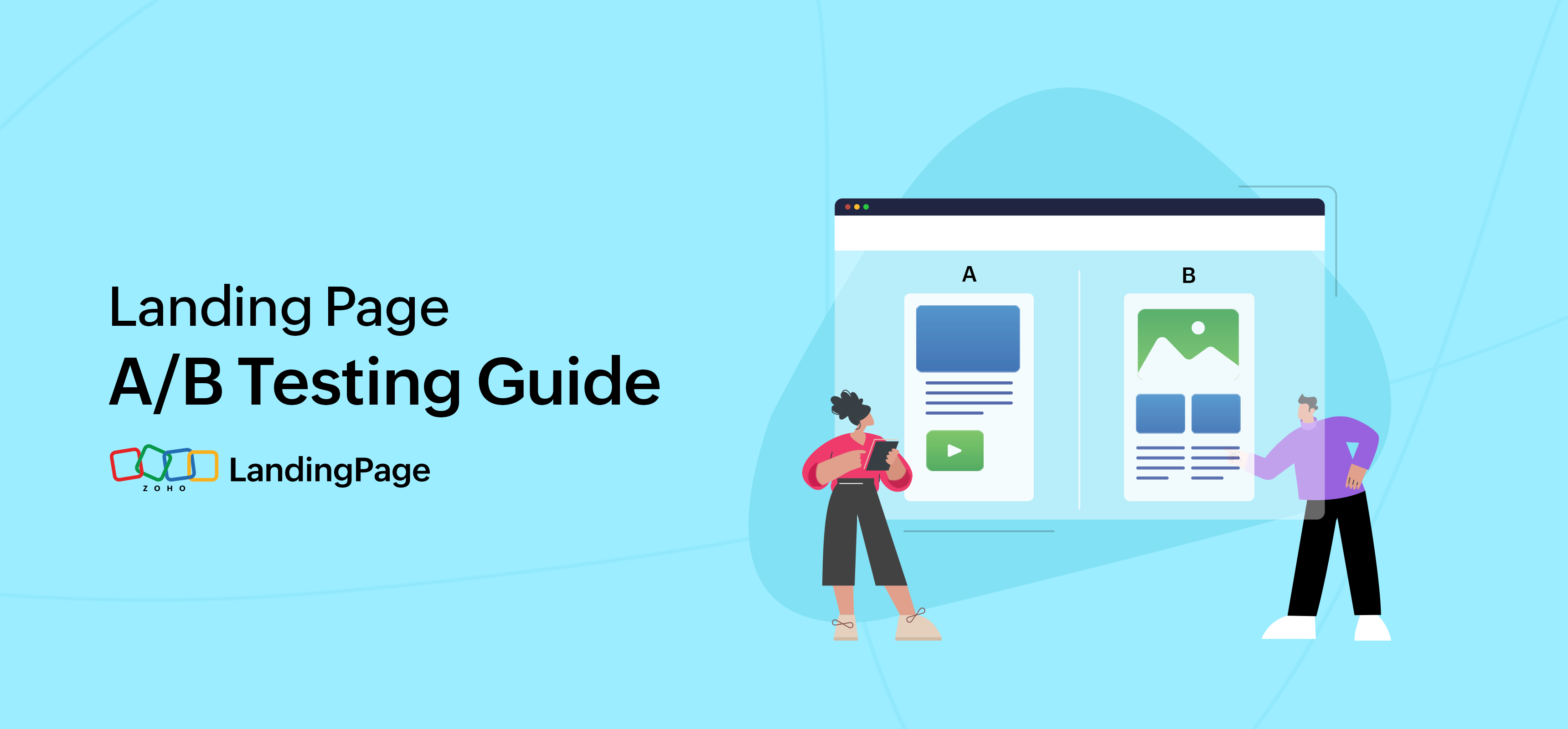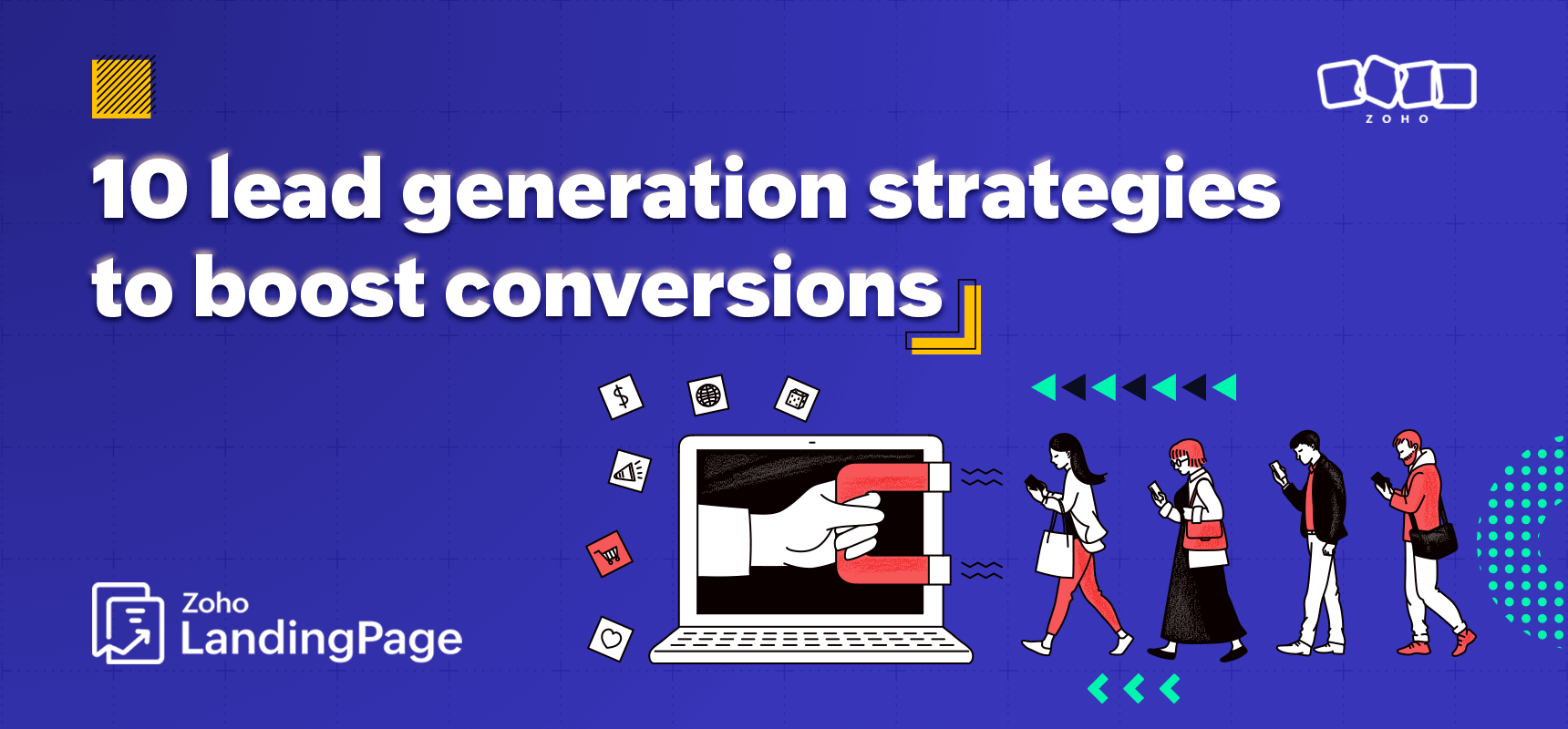Landing Page A/B Testing: Step-by-Step Guide for High Conversions
- Last Updated : October 7, 2024
- 3.0K Views
- 6 Min Read

Landing page A/B testing is the process of comparing different versions of a landing page simultaneously to find out which one gets more clicks and conversions. All landing pages need great design and a persuasive offer. But marketers who consistently create successful landing pages swear by this extra step of A/B testing to create high-converting landing pages.
Table of Contents
What is landing page A/B testing?
Like the name suggests, A/B testing is the process of simultaneously comparing variants of a landing page to identify the one that brings in more clicks and conversions.
Once you publish your landing page, you can create a version of the landing page in which one element, such as the headline or CTA button, is different. Visitors will be served one version of the landing page. After running the landing page A/B test for a considerable period of time, you can arrive at a conclusion about the better-performing landing page between the two.
The winning landing page is then served to all users. Remember, A/B testing is a continuous process where landing page performance needs to be consistently improved by testing them against new variants.
How does A/B testing work?
A/B testing works by creating multiple versions of a landing page to see which one performs better in achieving specific goals, like increasing sign-ups. You randomly split your website traffic between the versions and track metrics such as conversion rates and clicks.
After collecting enough data, you analyze the results to determine which version was more effective. If one outperforms the other, you implement that version as the main page and continue testing new ideas to optimize further. This process allows for data-driven improvements to enhance user experience and boost results.
Why should you A/B test your landing pages?
Enhance conversion rates
When users arrive at your landing page, they have a short time to engage with your page and decide whether they want to purchase your product or service. A/B testing is one of the most accurate, data-backed methods to ensure your landing page is best optimized for conversions.
Make landing page improvements
Marketing teams are constantly trying to improve their baseline. Changing a landing page element could adversely affect the conversion rate of a well-performing landing page. A/B testing is a risk-free method to make improvements to your marketing campaigns without losing out on conversions.
Learn about your visitors
By A/B testing landing pages over time, you can gain a holistic understanding of user behavior and improve the overall user experience of your marketing campaigns.
What to A/B test on landing pages?
Deciding what to test on your landing page is crucial. You can choose any element on the landing page as your variable, from headline to call to action. However, remember, irrespective how you decide to do your landing page testing, it is crucial to test one element at a time to get meaningful results.
Hero image vs. video
The primary visual element that depicts the value or offer of your landing page is typically a hero image or a video. While A/B testing, you can choose to use images or videos as your principal landing page visual. By varying the visual in the variant, you can identify which works better for the particular campaign and audience. You can also deploy variations in the type of image or video. For example, you can see whether a product image, photographic representation of users, or graphical illustrations would be better for the landing page.

Headlines
The headline is one of the first things users will see when they get to your landing page. It is also an important factor when visitors decide whether they want to stay on your page or leave. You can try different variations such as short vs. long headlines, positive vs. negative tones, problems vs. benefits, or a playful vs. professional approach in the headline to understand which caters best to your audience.
Short vs. long landing page
The length of the landing page is an important factor that affects your conversion rate. Some products may require longer, detailed landing pages to bring in conversions and some products can bring in the same conversions with a concise landing page that does not elaborate much. By testing out both these formats, you can understand the preferred length and implement it in all future landing page campaigns.

Order of elements
There is no universal format for creating landing pages but most high-converting landing pages follow a similar pattern: A prominent headline and an image or video followed by product or service features, and an attractive form with a CTA button.
Try moving the form up or down on the landing page to identify which location brings in better conversions. While some landing pages can display a lead generation form upfront and achieve success, others will have to convince users more before asking for their information. By simply shaking up the placement of elements on your landing page, you can easily identify the elements that make an impact and the elements that don't.

Forms
In lead generation campaigns, the form is the most prominent element on the landing page. To persuade users to share their information, forms have to be easy to fill and attractive. When using the form as your variable, you can change the placement, design, color, and number of form fields to identify the form type that brings in more leads.

Call-to-action button
Anybody who starts A/B testing their landing pages usually starts it by testing their call-to-action buttons. You can try to vary the shape, color, placement, font size, and language used in the CTA button to determine the perfect call-to-action button for the page.

How to do landing page A/B testing?
Landing page A/B testing may sound like a complex science experiment to a newbie but it is a fairly simple process that helps users consistently improve landing page conversions. Learn how you can A/B test your landing pages in Zoho LandingPage.
First, identify your landing page variable with the help of landing page analytics such as heat maps, scroll maps, attention maps, and form reports. Once you identify where users are bouncing away, which landing page element is uninteresting to them, or why forms are not being completed, you can use A/B testing to rectify the mistakes and improve conversions.
Second, the existing landing page becomes the "A" variant or the control version. Make a change in the selected variable to create the "B" variant or the challenger landing page. Split the audience equally for both versions to get accurate results.
Third, run your A/B test for as long as it takes to gather meaningful results. If you have high web traffic, running your landing page for a week or two can clearly identify the winning landing page variant. However, for businesses with low, inconsistent traffic, short A/B tests can be pointless, so those businesses need to test longer to collect more data. Finally, once you end the A/B test, analyze the results and serve the winning variant to all your users.
Key metrics to measure while landing page A/B testing
While landing page A/B testing it's crucial to measure the conversion rate (the percentage of visitors completing the desired action), total visitors, and the number of conversions.
Total visitors gives you a sense of the volume of traffic each version is receiving, which is important for statistical significance. The number of conversions provides absolute figures, allowing you to see how many people engaged with your call-to-action, regardless of the total traffic.
The conversion rate is crucial because it directly reflects how well your landing page is persuading visitors to take action, such as signing up for a newsletter or making a purchase. A higher conversion rate indicates that the changes made in the variant are resonating with your audience.
Mistakes to avoid while A/B testing landing pages
When A/B testing landing pages, avoid common mistakes like changing multiple elements at once, leading to unreliable results. Ensure you run tests for a sufficient duration to capture user behavior and always check for statistical significance before making decisions.
Rushing to implement changes based on initial results can lead to missed opportunities for further optimization. Be aware of external factors like seasonality that could impact your results. Lastly, periodically test landing page elements to keep improving the landing page experience for users to maintain good conversion rates.By steering clear of these pitfalls, you can make better decisions to enhance your landing page performance.
 Krithika
KrithikaContent Marketer @ Zoho LandingPage










